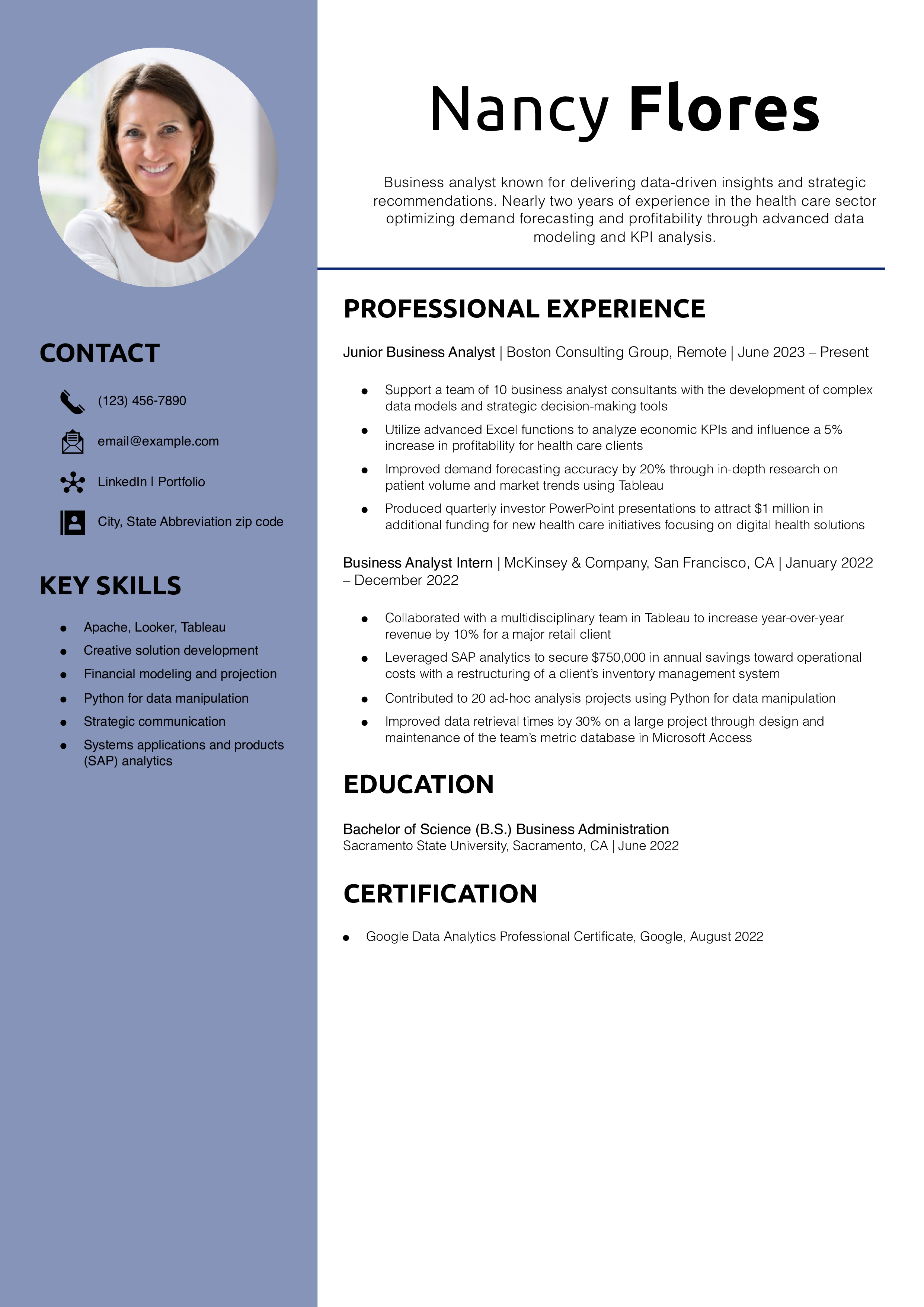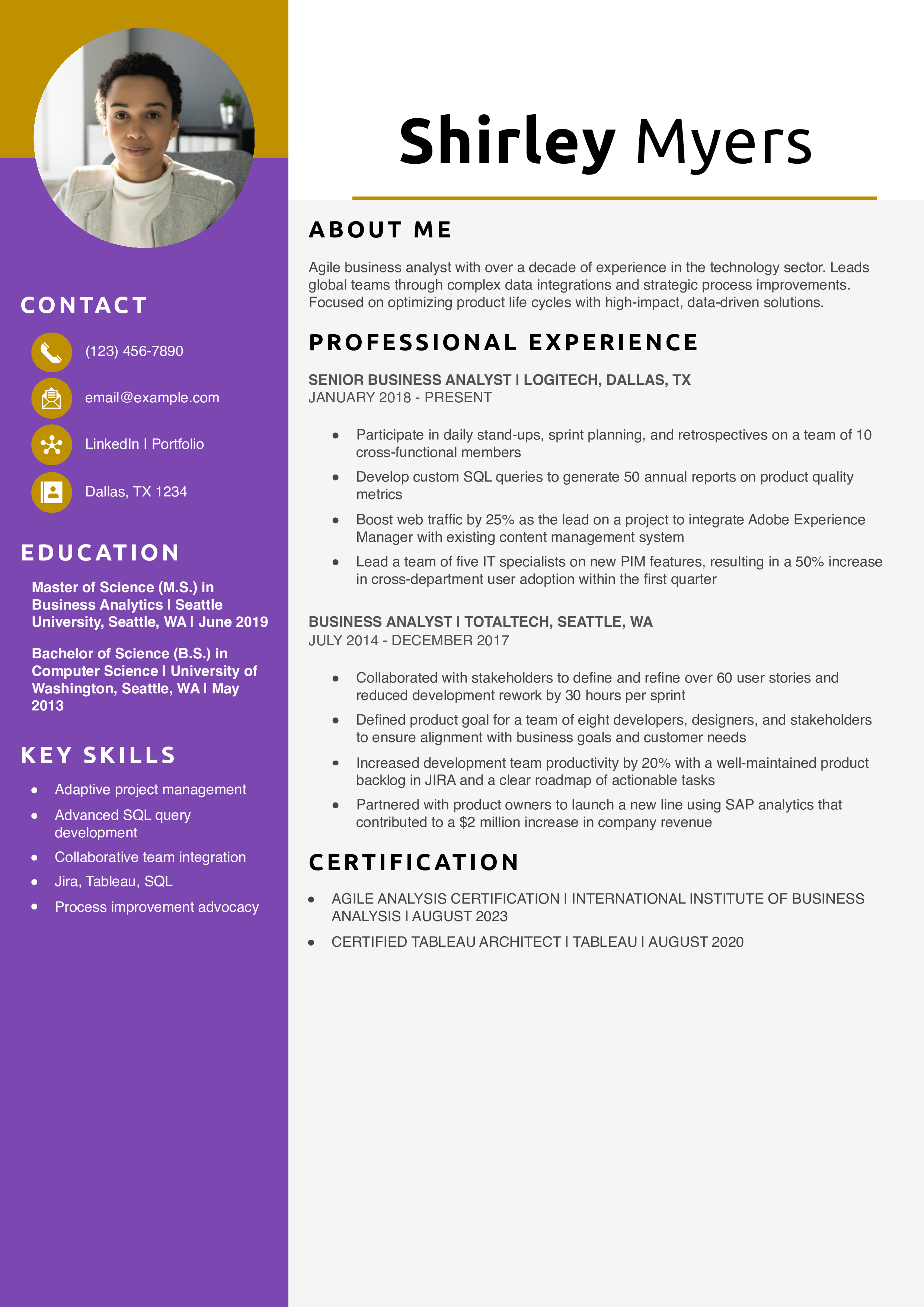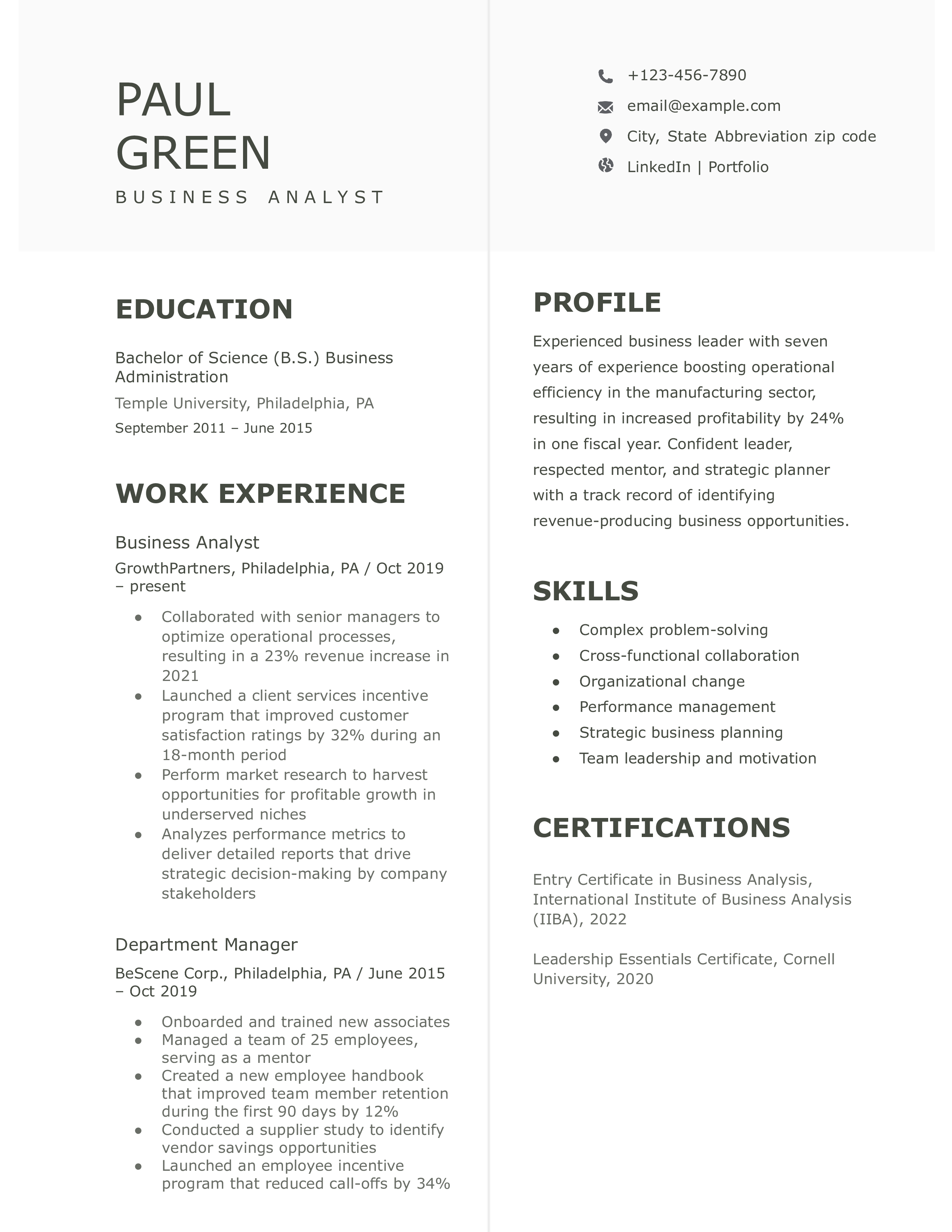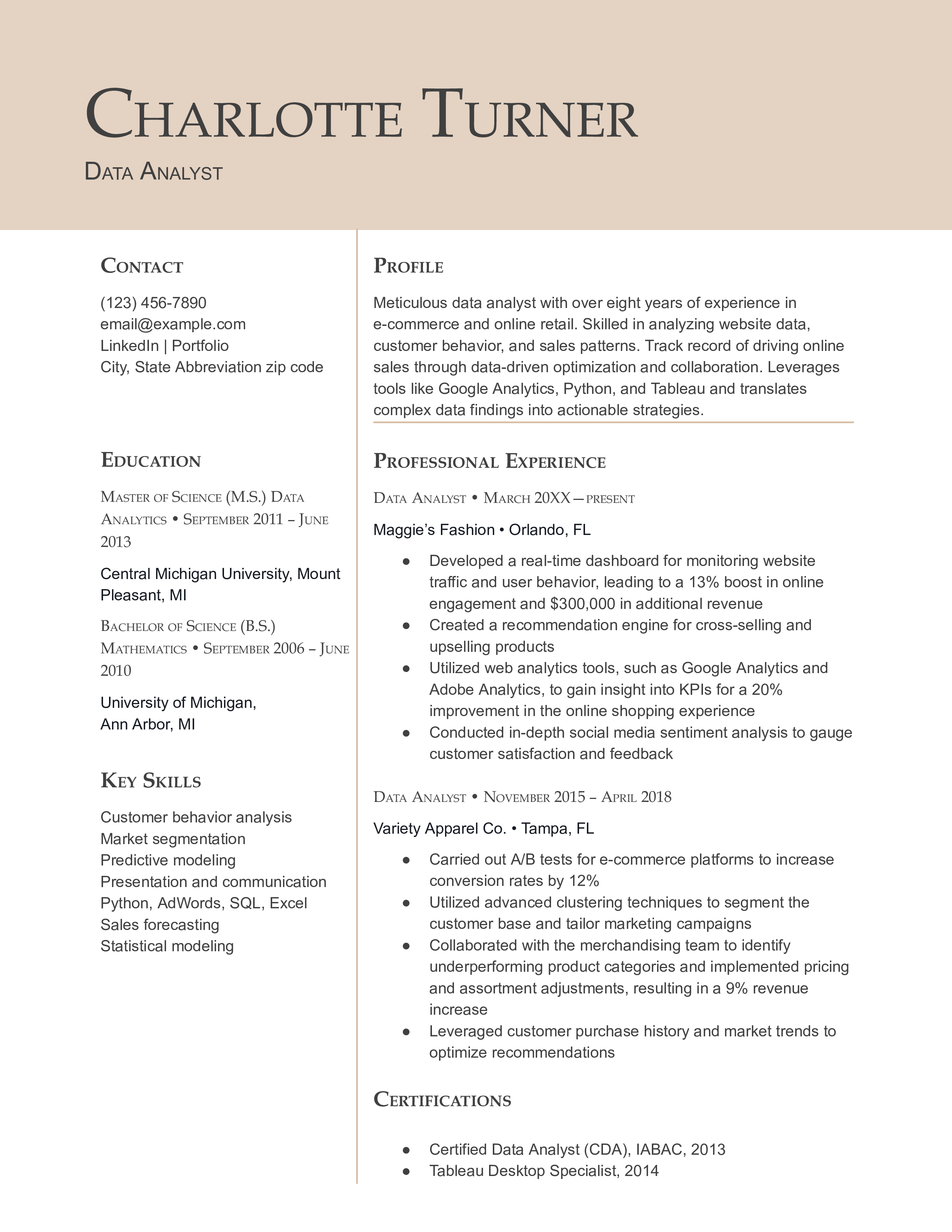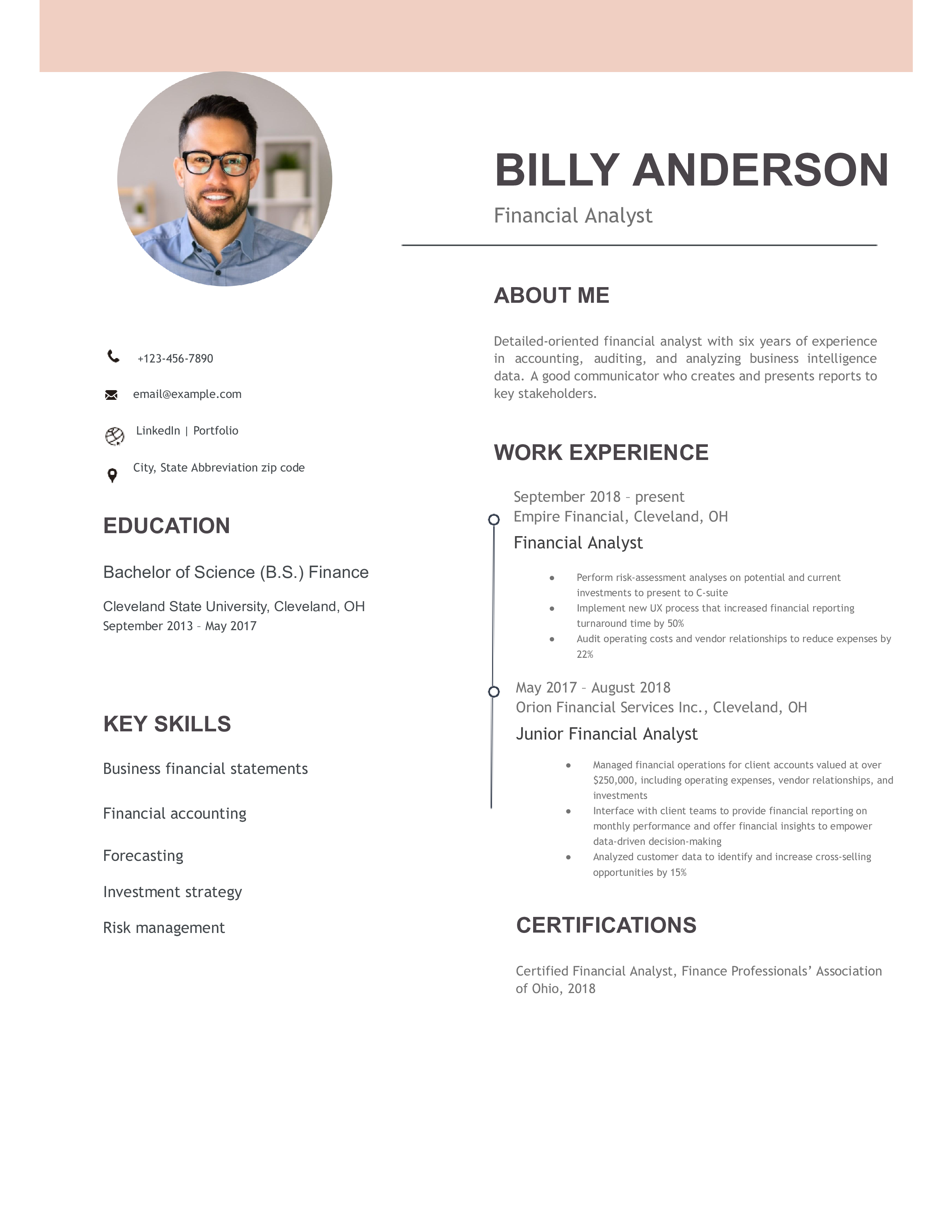Business Analyst Resume Examples and Templates (Downloadable)
- Entry-Level Business Analyst
- Mid-Level Business Analyst
- Senior Level Business Analyst
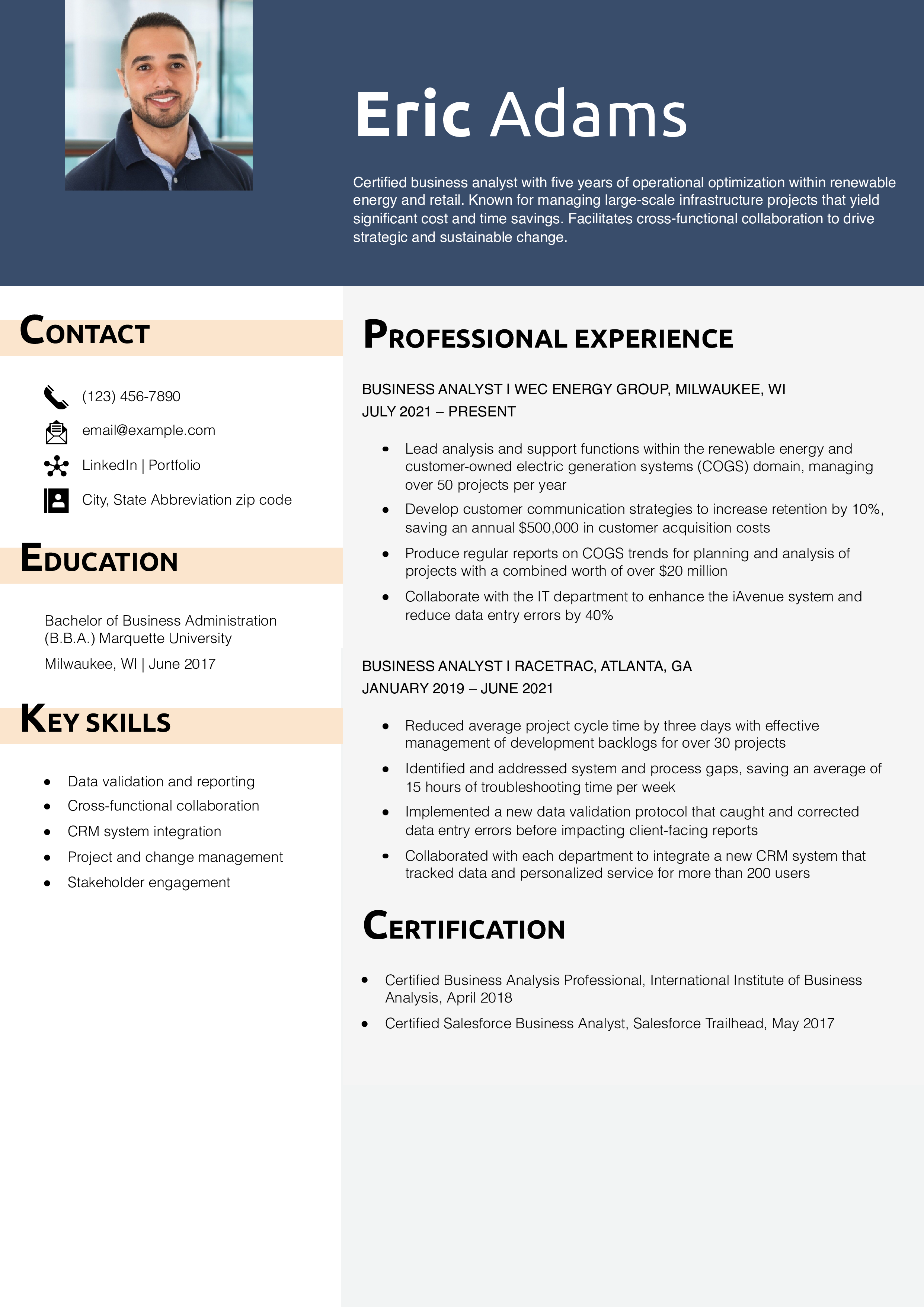
Organizations depend on analytical insight to make well-informed, data-driven decisions. Your business analyst resume should highlight an ability to harness raw data, transform it into a strategic plan of action, and effectively communicate these plans with business teams. We’ll cover resume-writing basics and provide expert tips to help create a document highlighting your unique career achievements.
Key takeaways:
- Emphasize analytical strengths: Immediately convey your ability to develop and execute business insights within the resume profile. Describing industry knowledge and experience will pique the reader’s interest as soon as they start reading your resume.
- Quantify past success: You know how powerful numbers can be, so use them to describe your work history and accomplishments. Quantify the results you’ve achieved in things such as revenue growth, cost reductions, project delivery times, and scalability.
- Include keywords for ATS: Optimizing your resume for Applicant Tracking Systems (ATS) starts with using keywords and phrases. Not just any words, though. Incorporate those you find in the job description that match your own business analysis skills.
How To Write a Business Analyst Resume Example
A great business analyst resume will show how you can connect business and technology using data. To ensure you include all of the most important aspects of your career history, include these sections in your resume:
- Contact information
- Profile
- Key skills
- Professional experience
- Education and certifications
1. Share your contact information
In the resume header, provide your full name, phone number, email address, location, and a link to any online profiles or portfolios. Before sending off your resume, be sure all of your info is up to date so hiring managers can easily schedule an interview.
Example
Your Name
(123) 456-7890
[email protected]
City, State Abbreviation Zip Code
LinkedIn | Portfolio
2. Add a compelling section featuring your business analyst experience
A resume profile is a brief summarization of your unique experience and qualifications. It should include a few engaging sentences about your business analyst background and key strengths. For inspiration on what to write about, look at the job description of the position you’re applying for and match up your specializations with key requirements.
If you excel in developing predictive models and the company you’re interested in working for needs help to optimize its supply chain, include that. Or maybe your career focus has been on risk management, and you’re confident it could help a company reduce operational vulnerabilities. Lead into your resume with facts like these to hook the reader.
Senior-Level Profile Example
Agile business analyst with over a decade of experience in the technology sector. Leads global teams through complex data integrations and strategic process improvements. Focused on optimizing product life cycles with high-impact, data-driven solutions.
Entry-Level Profile Example
Business analyst known for delivering data-driven insights and strategic recommendations. Nearly two years of experience in the health care sector optimizing demand forecasting and profitability through advanced data modeling and key performance indicators (KPI) analysis.
3. Create a powerful list of your business analyst experience
The work history section of your resume should outline your latest and most relevant jobs. List the job title, employer name, location, and dates of employment. Each description should give a general idea of your core responsibilities, with a focus on demonstrating how you used your analytical skills to impact business decisions and outcomes.
While you play a technical role in helping businesses analyze data, your ability to facilitate change is vital. Mention your experience guiding departments through transitions or adjusting workflows. Show you can use those soft skills to communicate effectively and maintain momentum on projects and initiatives.
Senior-Level Professional Experience Example
Senior Business Analyst, Logitech, Dallas, TX
January 2018 – present
- Participate in daily stand-ups, sprint planning, and retrospectives on a team of 10 cross-functional members
- Develop custom SQL queries to generate 50 annual reports on product quality metrics
- Boost web traffic by 25% as the lead on a project to integrate Adobe Experience Manager with the existing content management system
- Lead a team of five IT specialists on new product information management (PIM) features, resulting in a 50% increase in cross-department user adoption within the first quarter
Entry-Level Professional Experience Example
Junior Business Analyst, Boston Consulting Group, Remote
June 2023 – present
- Support a team of 10 business analyst consultants with the development of complex data models and strategic decision-making tools
- Utilize advanced Excel functions to analyze economic KPIs and influence a 5% increase in profitability for health care clients
- Improved demand forecasting accuracy by 20% through in-depth research on patient volume and market trends using Tableau
- Produced quarterly investor PowerPoint presentations to attract $1 million in additional funding for new health care initiatives focusing on digital health solutions
Resume writer’s tip: Quantify your experience
Data is key to understanding the potential of a business. Similarly, numbers help hiring managers understand the potential value you could bring to their team. Use KPIs and monetary figures to describe how you’ve done things like optimize data models or reduce business costs. Provide hiring managers with evidence of real results.
Do
- “Optimized data models to increase client service delivery speed by 25% and reduce operational costs by $200,000 within the first year.”
Don’t
- “Worked on optimizing data models to reduce business costs.”
Resume writer’s tip: Tailor your resume for each application
Just like the same business strategy won’t work for every company, a generic resume isn’t likely to land you many interviews. Each organization has its own unique challenges and business goals. So, adjust your resume accordingly to show you can meet those needs.
Take note of the terms and themes that come up around job requirements, skills, preferred certifications, software proficiencies, and tools. As you match up your own experiences, weave those phrases and topics naturally throughout your resume. Avoid copying large bodies of text word-for-word, as this can have a negative effect and could be flagged as spam in ATS programs.
What if you don’t have experience?
If you understand the core function and daily responsibilities of a business analyst, you can make up for a lack of experience by leveraging relevant skills. Then, take that understanding further by studying the job description of each role you apply for. Match your existing abilities with those required for the job and customize your resume accordingly.
Internships, mentorships, education, and software knowledge can all help you build out your entry-level business analyst resume. Or, consider earning a certification like the Entry Certificate in Business Analysis. This is a great way to demonstrate your foundational knowledge and prove to hiring managers that you’re a competent early-career candidate.
4. List any education and certifications relevant to business analysis
Most employers want to see at least a bachelor’s degree for a business analyst position. Some common majors include business, finance, economics, and information technology (IT). If you have a higher degree in a relevant major, list that first.
Then, include any role-specific certifications you may have from reputable organizations like the International Institute of Business Analysis (IBBA) or Project Management Institute (PMI). Scrum, Agile, and Six Sigma credentials would also help you stand out from other applicants.
Education
Template:
[Degree Name]
[School Name], [City, State Abbreviation] | [Graduation Year]
Example:
Bachelor of Business Administration (B.B.A.)
Marquette University, Milwaukee, WI | June 2017
Education
Template:
[Certification Name], [Awarding Organization], [Completion Year]
Example:
Certified Business Analysis Professional, International Institute of Business Analysis, 2018
5. Outline your most useful business analyst skills and proficiencies
Business analysis is a multifaceted job. It entails highly technical data and communicating with business teams to share practical steps. This requires a unique fusion of hard and soft skills to be successful in your work. By including both types of skills on your resume, you show hiring managers you have what it takes to navigate technical complexities and contribute to a healthy work culture.
| Hard Skills | |
|---|---|
| Agile methodologies | Business intelligence tools |
| Client relationship management (CRM) systems | Data warehousing |
| PIM systems | Process modeling |
| Requirements gathering | SQL and database management |
| Statistical analysis | Unified modeling language (UML) and use cases |
| Soft Skills | |
|---|---|
| Analytical reasoning | Change management |
| Creative solution development | Cross-functional leadership |
| Emotional intelligence | Facilitation |
| Market research | Stakeholder engagement |
Resume writer’s tip: Use strong action verbs
Action verbs help to communicate your accomplishments clearly. Instead of listing off your tasks, you can frame them as achievements by using action verbs. This captures the attention of hiring managers and allows you to be concise with your descriptions, avoiding repetitive first-person language. Utilize words like these to enhance your business analyst resume:
| Action Verbs | |
|---|---|
| Advised | Analyzed |
| Collaborated | Engineered |
| Evaluated | Executed |
| Facilitated | Implemented |
| Optimized | Orchestrated |
| Resolved | Spearheaded |
| Streamlined | Synthesized |
How To Pick the Best Business Analyst Resume Template
Selecting a resume template is more than a matter of aesthetics — it’s about presenting your unique work history in the best possible way. For a business analyst, that means choosing a clean, well-structured layout.
An organized and uncluttered resume helps hiring managers quickly scan through your document without being distracted by walls of text and flashy graphics. Modern designs are a great option, often leveraging a minimalist approach and conveying a professional image.
Business Analyst Text-Only Resume Examples and Templates
Nancy Flores
(123) 456-7890
[email protected]
City, State Abbreviation zip code
LinkedIn | Portfolio
Profile
Business analyst known for delivering data-driven insights and strategic recommendations. Nearly two years of experience in the health care sector optimizing demand forecasting and profitability through advanced data modeling and KPI analysis.
Key Skills
- Apache, Looker, Tableau
- Creative solution development
- Financial modeling and projection
- Python for data manipulation
- Strategic communication
- Systems applications and products (SAP) analytics
Professional Experience
Junior Business Analyst, Boston Consulting Group, Remote
June 2023 – present
- Support a team of 10 business analyst consultants with the development of complex data models and strategic decision-making tools
- Utilize advanced Excel functions to analyze economic KPIs and influence a 5% increase in profitability for health care clients
- Improved demand forecasting accuracy by 20% through in-depth research on patient volume and market trends using Tableau
- Produced quarterly investor PowerPoint presentations to attract $1 million in additional funding for new health care initiatives focusing on digital health solutions
Business Analyst Intern, McKinsey & Company, San Francisco, CA
January 2022 – December 2022
- Collaborated with a multidisciplinary team in Tableau to increase year-over-year revenue by 10% for a major retail client
- Leveraged SAP analytics to secure $750,000 in annual savings toward operational costs with a restructuring of a client’s inventory management system
- Contributed to 20 ad-hoc analysis projects using Python for data manipulation
- Improved data retrieval times by 30% on a large project through design and maintenance of the team’s metric database in Microsoft Access
Education
Bachelor of Science (B.S.) in Business Administration
Sacramento State University, Sacramento, CA | June 2022
Certifications
- Google Data Analytics Professional Certificate, Google, 2022
Frequently Asked Questions: Business Analyst Resume Examples and Advice
How do you align your resume with a business analyst job description?
When you gather data for a business, you’re collecting information specific to that organization. Do the same when writing your business analyst resume to understand exactly what a company is looking for. This will help align your resume with the job description and increase your chances of landing the best business analyst position in a fast-growing job market.
Determine how your skills and experience match up and prioritize incorporating that information into your resume. For example, suppose a financial services company needs someone who can improve forecasting accuracy. Then, you would match up your experience with financial modeling tools and present past projects where you successfully predicted financial trends.
What is the best business analyst resume format?
If you’re an experienced business analyst, the reverse chronological resume is ideal. It prioritizes your extensive experience in business analysis and presents your career journey in a clear progression. Your skills and education take on a smaller role overall, allowing your work history to shine.
On the other hand, if you lack professional experience or would rather highlight your skills, the combination format is a good option. This balanced approach emphasizes your many unique analytical and leadership abilities first, with a smaller work history section.
include a cover letter with your resume
Bring the data points of your resume to life with an accompanying cover letter. This simple addition can set you apart from other applicants. It’s your chance to explain how your technical skills and business insight could translate into success for potential employers. Include one with your resume to connect with the hiring team and convey your enthusiasm for the role.
Check Out Related Examples
Resume Templates offers free, HR approved resume templates to help you create a professional resume in minutes. Choose from several template options and even pre-populate a resume from your profile.

